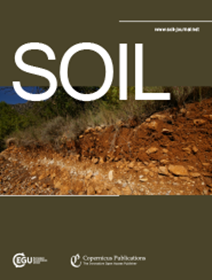Changes in carbon functional groups and their in situ microscale distribution under long-term continuous cropping
IF 4.3
2区 农林科学
Q1 SOIL SCIENCE
引用次数: 0
Abstract
Abstract. Land use change is causing substantial loss of soil organic carbon (SOC). However, little is known regarding how this loss of SOC influences the composition of carbon (C) functional groups and their microscale distribution, with this being critical to the protection and storage of SOC. In this study, we examined the mechanisms influencing preservation of C forms and their distribution by comparing soils under native vegetation and cropping at two Australian sites, Waco black Vertisol (70 y cropping) and Langlands-Logie grey Vertisol (10 y cropping). Land use change caused the loss of up to 23 % (5.3 mg C g-1 soil) of bulk SOC. Strikingly, the greatest loss occurred in the mineral-associated organic carbon (MAOC) fraction that accounted for 72–91 % of total SOC. Interestingly, despite losing up to 23 % of the bulk SOC, the C that remained after long-term cropping was similar in speciation to that in the native soils revealed by near edge X-ray absorption fine structure spectroscopy. In a similar manner, the use of infrared microspectroscopy showed that the forms of C remained similar in the two land uses and that C was closely associated with clay minerals. This suggests that the SOC loss from mineral fraction was not due to preferential consumption of particular forms of carbon, but rather, an overall loss of SOC in the mineral fractions and an increase in overall lability. These observations provide critical evidence that preservation of SOC is not driven by increasing compositional diversity or complexity in these Vertisols and that physical protection of C is of importance. Potential exists to rebuild SOC in the mineral-associated fraction under cropping. Management practices should promote the building of organo-mineral associations.长期连作条件下碳官能团的变化及其原位微尺度分布
摘要。土地利用变化导致土壤有机碳(SOC)大量流失。然而,人们对有机碳的损失如何影响碳(C)官能团的组成及其微尺度分布知之甚少,而这对有机碳的保护和储存至关重要。在这项研究中,我们通过比较两个澳大利亚地点的原生植被和种植下的土壤,Waco黑色垂直土壤(70年种植)和Langlands-Logie灰色垂直土壤(10年种植),研究了影响C形态保存及其分布的机制。土地利用变化导致土壤有机碳损失高达23% (5.3 mg C g-1土壤)。值得注意的是,最大的损失发生在矿物相关有机碳(MAOC)部分,占总有机碳的72 - 91%。有趣的是,近边x射线吸收精细结构光谱显示,长期种植后,尽管损失了23%的有机碳,但保留的碳在物种形态上与原生土壤相似。同样,利用红外显微光谱分析表明,C的形态在两种土地利用中保持相似,并且C与粘土矿物密切相关。这表明矿物组分的有机碳损失不是由于特定形式的碳的优先消耗,而是由于矿物组分中有机碳的总体损失和总体不稳定度的增加。这些观察结果提供了重要的证据,证明有机碳的保存不是由这些垂直土壤中增加的成分多样性或复杂性驱动的,并且对碳的物理保护是重要的。在种植条件下,矿物伴生部分存在重建有机碳的潜力。管理实践应促进有机矿物协会的建设。
本文章由计算机程序翻译,如有差异,请以英文原文为准。
求助全文
约1分钟内获得全文
求助全文
来源期刊

Soil
Agricultural and Biological Sciences-Soil Science
CiteScore
10.80
自引率
2.90%
发文量
44
审稿时长
30 weeks
期刊介绍:
SOIL is an international scientific journal dedicated to the publication and discussion of high-quality research in the field of soil system sciences.
SOIL is at the interface between the atmosphere, lithosphere, hydrosphere, and biosphere. SOIL publishes scientific research that contributes to understanding the soil system and its interaction with humans and the entire Earth system. The scope of the journal includes all topics that fall within the study of soil science as a discipline, with an emphasis on studies that integrate soil science with other sciences (hydrology, agronomy, socio-economics, health sciences, atmospheric sciences, etc.).
 求助内容:
求助内容: 应助结果提醒方式:
应助结果提醒方式:


